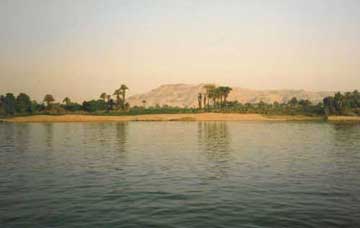Natural Resources in Ancient Egypt
 The greatest natural resource in Ancient Egypt was the Nile River. The river provided fish, transportation, and an annual flood that fertilized the land for growing good crops. Egypt also had other items of natural resources in rocks and metals.
The greatest natural resource in Ancient Egypt was the Nile River. The river provided fish, transportation, and an annual flood that fertilized the land for growing good crops. Egypt also had other items of natural resources in rocks and metals.
 Different types of rocks and minerals were quarried in Ancient Egypt. The Egyptians mined large blocks of rock by drilling holes in a line in a rock’s surface. The holes were filled with wedges of wood. Wetting the wooden wedges caused them to expand, and after a period of time, the rock split along the line of the drilled holes.
Different types of rocks and minerals were quarried in Ancient Egypt. The Egyptians mined large blocks of rock by drilling holes in a line in a rock’s surface. The holes were filled with wedges of wood. Wetting the wooden wedges caused them to expand, and after a period of time, the rock split along the line of the drilled holes.
The Egyptians mined from various areas in Egypt. White limestone came from quarries near Memphis, quartzite from Gebel el-Ahmar, and sandstone from Gebel es-Silsila. Alabaster was quarried out of the eastern desert. Granite quarries were found around Aswan.
Copper was the main metal used in Ancient Egypt . Copper comes naturally mixed with other minerals in an ore form. The ore had to be heated to remove the copper from the other elements. The Egyptians used a heating process called smelting to remove any impurities from the copper. To do this, they placed the ore with charcoal into a pit located in a windy area. They lit the charcoal and the wind stoked the fire to nearly the thousand degrees centigrade needed to separate the copper from the ore. In later times, the Egyptians used a bellow system to get the needed oxygen to stoke the fire to the necessary temperature.
Flint was another important stone for Ancient Egyptians. It was used in making sickles for harvesting crops and in making weapons. Steatite, another type of stone, was used in making scarabs. Scarabs were inexpensive charms which held a religious meaning to the early Egyptians.
Egypt lacked good trees for wood due to the dryness of the climate. Cedar wood had to be imported from Lebanon to meet the Egyptians’ needs.
Flax was another natural resource that Egypt developed. Flax grew well in the fertile Nile Valley. It was pulled out by the roots and then dried. Seeds were removed, and the core of the plant was placed in water for a week or more. Then they beat and separated it into parts that were spun into linen cloth.
Another naturally grown crop in Egypt was papyrus. It was made into writing material, a predecessor to paper. The papyrus plant grew in several feet of water. It was pulled out, and the stem was cut into strips. The strips were overlaid in vertical and horizontal layers and put under pressure by pounding it together. The sap of the plant acted like a glue after it dried, holding the strips together in a white loose-textured paper.
Miscellaneous Page on Ancient Egypt
Egyptian Military Major Military Battles Transportation
Natural Resources Farming Foreign Trade Bibliography
Return to Ancient Egypt Main Page

